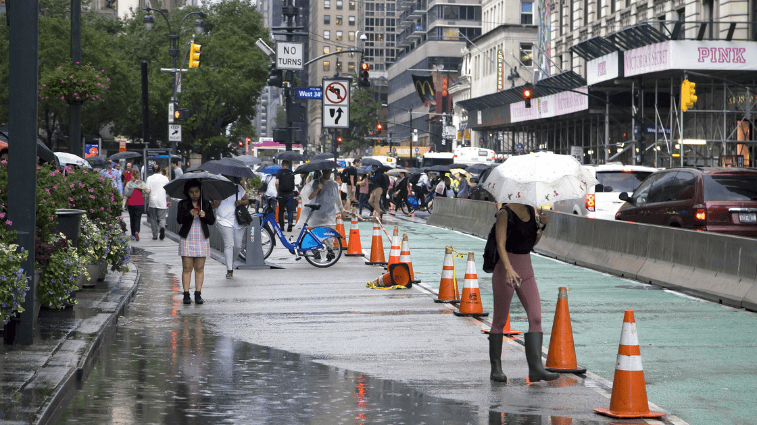
NYC’s Infrastructure Fails to Prevent Flooding — How Can It Improve?
On September 29th, Tropical Storm Ophelia brought New York City to its knees and left its inhabitants knee-deep in floodwater. What began as a “rainy week” quickly escalated into a State of Emergency that demonstrated, for a second time since Hurricane Ida in 2021, the ineffectiveness of NYC infrastructure in combating extreme weather events. Floodwater burst through the caulk of subway tiles, sewer drains clogged with swirling trash, and buses became boats. By the end of the day, the city had received as much rainfall as it usually would in two to three months, according to MTA Chair and CEO Janno Lieber. Flooding due to extreme rainfall could be written off as uncommon, but events such as these will likely only increase in frequency as climate change effects escalate. If the September flooding taught us anything, it’s that this lesson will not be the last of its kind.
Why is NYC in particular so ill-suited to rain? Most of the city sits atop non-porous concrete, which had been saturated with a week’s worth of rainfall by the time flooding began on September 29th. There are also very few areas of greenery throughout NYC that can accommodate the runoff that sewers can’t, and the city’s drainage system becomes overloaded easily after extended periods of rain.
The city has initiatives in place to combat flooding, some of which are more successful than others. After Hurricane Ida, which occurred under Former Mayor DeBlasio’s administration, the city released a guidebook for combating extreme weather titled “The New Normal,” which outlined emergency procedures and proposed improvements for drainage systems. Since then, Mayor Adams has released “Rainfall Ready,” which theorized about short-term green infrastructure projects that would be complete by June 2023. However, a 2023 audit of the Metropolitan Transportation Authority (MTA) revealed a failure to meet the expectations of defense against extreme weather. The city found that most capital projects intended to prevent or correct weather damage were incomplete or undocumented and that the MTA has yet to complete the critical development of a climate change master plan. This information is likely unsurprising to anyone who commuted during last September’s floods.
More successful initiatives against flooding include rain gardens, which are strategically placed patches of greenery that collect and absorb stormwater before it overloads the sewers. They have a tendency to collect litter that drifts along local waterways, however, which the Department of Environmental Protection (DEP) inspects and clears weekly. This system is not perfect, but it exemplifies the importance of innovative solutions for the city’s flawed infrastructure. Similar projects include infiltration basins, which store water under a surface that mimics its surroundings, such as grass or concrete. Many NYC buildings have also installed green roofs, which are layers of thick soil on rooftops that absorb and slowly drain stormwater. Another fascinating innovation is permeable paving, which allows water to seep through paving materials. Despite these efforts, no singular initiative can combat flooding on its own, and the most important dilemma to address is the city's sewage system, which fails to keep pace with the changing weather.
In April of 2023, Mayor Adams released PlaNYC, a long-term climate plan outlining important budgeting initiatives that intend to change the course of NYC infrastructure. Notable changes include extensive solar energy, green roofs, electric buildings, and other renewable energy installations on all viable city-owned properties by 2035. The city also intends to invest in coastal protection projects, incentivize privately owned buildings to comply with Local Law 97, and achieve a 30% tree canopy cover. If these improvements successfully develop at the proposed rate, the city might stand a chance against extreme weather. Unfortunately, regular flooding is an anticipated reality, so New Yorkers should brace themselves for impact.
How to Prepare
In a statement updating New Yorkers on the flooding situation, the Department of Buildings (DOB) announced they would be performing random spot-check inspections of construction sites, issuing violations, and stopping work orders if flooding issues were identified. These procedures provide an important reference for any future flooding, should a similar situation arise.
The DOB encouraged builders, contractors, and developers to:
- Secure loose material debris at construction sites
- Cover electrical equipment from rainfall
- Secure netting, scaffolding, and sidewalk sheds
- Clear roofs, overhangs, and gutters of standing water
- Brace and secure construction fences
- Call 911 if there is an emergency on a construction site
Property owners, on the other hand, are expected to:
- Bring loose, lightweight objects inside
- Anchor unsafe objects outside
- Secure and clear roofs, awnings, umbrellas, and overhangs of standing water
- Check to ensure all gutters, roof drains, and downspouts are cleared of debris
Extreme weather events are often unexpected, and while the city may do its best to prepare, rules and procedures change quickly. If you require assistance with navigating unprecedented zoning or building code guidelines, the experts at would be happy to help.
Resources
- Climate Change Indicators: Heavy Precipitation
- Mayor Adams Updates New Yorkers on Ongoing Flooding Response, Recovery Efforts
- Mayor Adams Releases "PlaNYC: Getting Sustainability Done," New York City's Strategic Climate Plan








